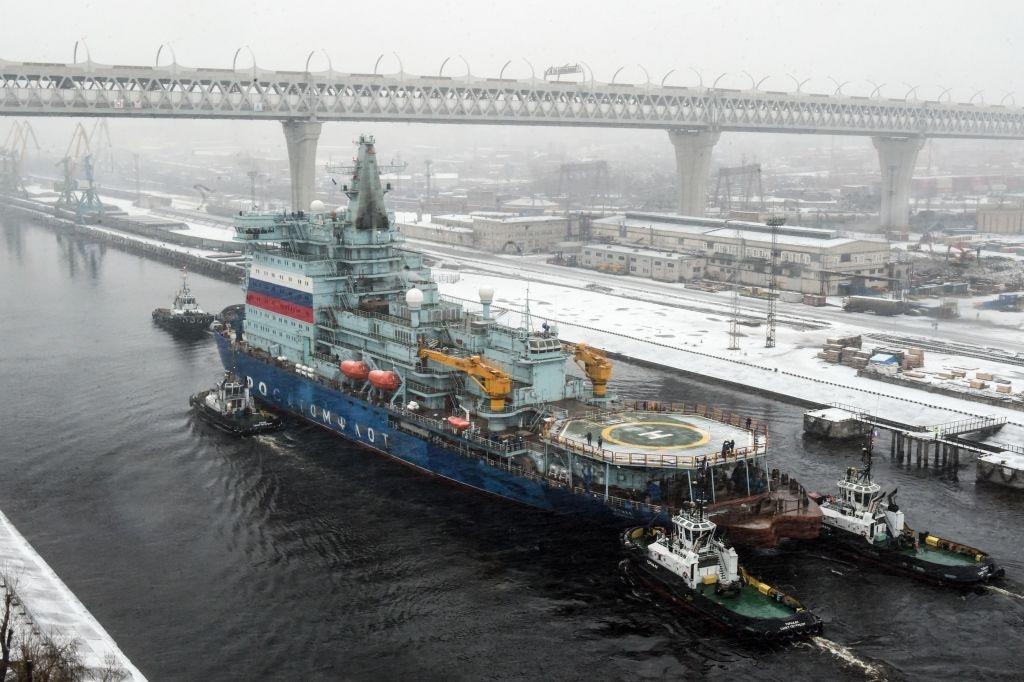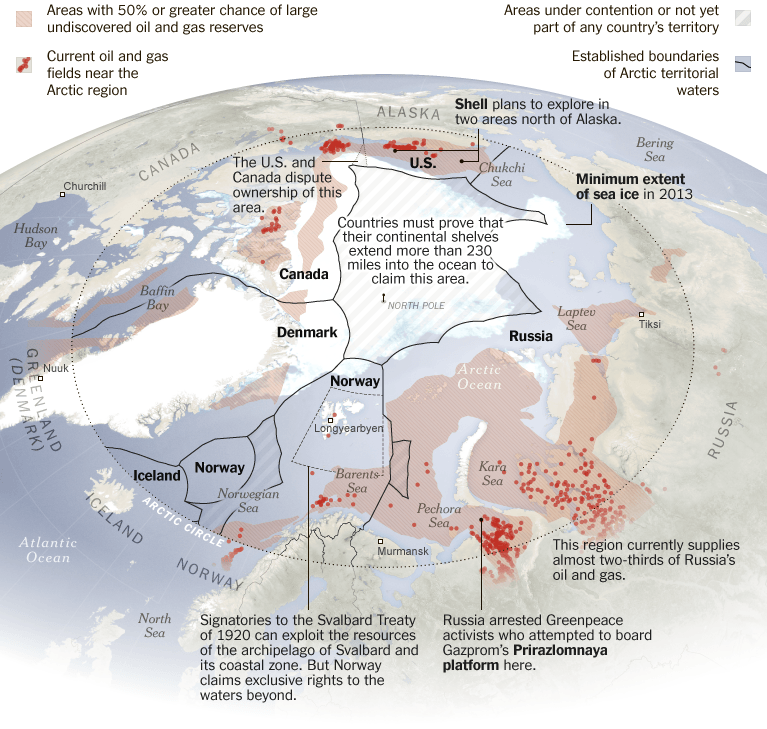Russia’s Arctic Empire
Tyler Durden
Sat, 05/30/2020 – 07:00
Authored by Lawrence Franklin via The Gatestone Institute,
Moscow sent a spectacular message last month to the world’s other Arctic powers: Russia is determined to dominate the region. Russian transport aircraft, breaking the record for the highest altitude jump ever, parachuted a group of their Spetsnaz (Special Forces) over the Arctic. from a height of almost 33,000 feet (Mt. Everest is 29,000 feet). Russian paratroops then executed a military exercise operation before reassembling at the Nagurskoye base, the northernmost military facility in Russia.
Any rival’s attempt to catch up and surpass Moscow’s head start in the Arctic is unlikely to succeed. Russia has a geopolitical advantage in that its sovereign land abuts over half of the Arctic’s territorial waters. Historically, Russia’s czars and commissars were frustrated in their attempts to secure warm-water ports, which would have benefited commerce and military force projection. Now, with environmental warming and subsequent accelerating ice-melt in the Arctic Ocean, Moscow appears poised to control the newest maritime corridor, “the Northeast Passage.” This waterway will unite Russian Europe with Russia’s Far East provinces adjacent to Pacific waters. The “Northeast Passage” could shorten the transshipment of goods from Asian countries to Europe by two weeks, rather than shipping goods through the Suez Canal route.
For centuries, ships could navigate only sections of the Arctic a few months of the year. If present climatic warming trends continue, however, and probably even if they do not, Russia seems to be expecting exclusively to exploit the region’s vast energy, mineral and fishing resources, at least within the legal limits of its 200 nautical mile exclusive economic zone beyond its land borders.
Russia’s northwestern Arctic territory of the Kola Peninsula accounts for large portions of the country’s nickel and copper output, as does Norilsk in East Siberia. The Arctic region also accounts for most of Russia’s tin extraction. Russian mining centers within the Arctic Circle produce valuable minerals, such as diamonds in the Yakutia Republic in Russia’s Far East, as well as palladium, platinum, selenium and cobalt. Probably the most famous minerals are the area’s legendary gold deposits in the Kolyma area.
Russia’s claim of exclusivity, or at least its special ties, to the Arctic are of long-standing. Moscow first claimed sovereignty over all the islands in the Arctic Sea north of its Eurasian land mass as early as 1926, and repeated this claim in 1928 and again in 1950. Russia’s claim of sovereign control of these islands, along with its nearly 25,000 kilometers of Arctic coastline, is considered part of the country’s historical patrimony and, therefore, its ownership supposedly non-negotiable.
Russia’s President Vladimir Putin seemed to be underscoring that axiom in his 2017 visit to the Franz Josef Land archipelago, the northernmost outpost in a region, where Russia’s claim of sovereignty includes 463,000 square miles of territory. All the same, these Russian claims have not yet been adjudicated by international law courts, the United Nations, or by any bilateral or multilateral treaty. Russia’s assertiveness, and the failure of the other Arctic nations to corral Moscow into negotiating definitive boundary treaties, leave significant potential for misunderstanding and serious international incidents in the Arctic seas. Russia’s blanket claims of territorial sovereignty pose a direct challenge to “Law of the Sea” conventions such as the “Freedom of Navigation” (FON) principle, championed by the U.S. and other Free World navies. The FON concept permits foreign vessels freely to ply waters outside the internationally recognized 12 nautical mile limit of sovereign national waters.
One longstanding territorial dispute fraught with tension is seen in the conflicting claims by Russia and NATO members Denmark and Canada over ownership of the Lomonosov Ridge. Nevertheless, some historical territorial counterclaims are negotiable, like the decades-old dispute between Russia and Norway over which country controlled the waters of the Barents Sea. Russia and Norway resolved the issue amicably in September 2010 with each country settling for 175,000 square km of the Barents waters.
The Kremlin continues integrating its industrial and military infrastructure in its Far North project, begun over a century ago. Pointedly, between 2015 and 2016, Moscow constructed six new military bases, at Aleksandra Land, Novaya Zemlya, Sredny Island, Wrangel Island, Kotelny Island, and Camp Schmidt. Russia maintains strict vigilance of the skies over its Arctic realm, and stations medium-range surface-to-air missile systems to assure control of its airspace. Russia’s military has also deployed a polar-capable version of its latest air defense weapon, the S-400. Lessons learned from the Red Army’s World War II winter combat against Germany’s invading forces guarantees that all Russian military weapons systems are operable at -50 degrees Celsius.
Russia, in addition, has a natural geopolitical and cultural advantage over rivals for hegemony in the land and waters in the Arctic Circle. Russian citizens seem more acclimated to the frigid climate of the far northern regions, as evidenced by Russia’s several large urban population centers in the far north such as: Murmansk, Vorkuta, Norilsk, and Tiksi.
Underscoring Russia’s apparent determination to dominate the Northern Sea Route (NSR) once the passage is completely navigable, Moscow has already proffered a jurisdictional regime to manage all commerce. Russia’s proposed NSR administration entails a mandatory 45-day advance application for right of passage, a hefty fee for passage, and the boarding of every vessel by a native Russian pilot to guide the ship into port. The U.S. will not likely comply with this proposal, as the U.S. Navy firmly adheres to the principle of mare liberum (“freedom of the seas”). In recent decades, the U.S. Navy has conducted hundreds of “Freedom of Navigation” military exercises around the world, and now may have to intensify such missions in the high north to prevent Moscow’s unchallenged dominance of the Arctic region.
The aspirations of the five polar nations — Russia, Denmark, Norway, Canada and the U.S. — may also have to contend with the ambitions of the People’s Republic of China. In the recent past, China and Russia have cooperated in navigation and commercial operation in the Arctic. Russia, owner of the world’s largest fleet of icebreakers, has on occasion deployed these vessels to escort Chinese maritime convoys in the far North’s frigid seas. It was Russia that also pioneered the building of the first nuclear-powered icebreaker, The Lenin, when passage in the Russian far north was restricted to the period from mid-July through the end of September. China is now busy producing its own icebreakers to ply Arctic waters. China evidently sees the Northern Corridor as a “Polar Silk Road” that will facilitate two-way commerce from Asia to the European Union. Now that the Northern Sea Route fully materialized last August, Russo-Chinese cooperation might also include China’s financing of cash-strapped Russia’s formidable development plans for military bases and modern ports. China’s insatiable appetite for coal has likely caused Beijing to cast an avaricious eye toward the Russian Arctic’s vast coal deposits in the Siberian region of Kemerovo, not far from the Sino-Russian border.
Perhaps a prudent path for the U.S. and Free World countries to adopt in the Arctic, given Moscow’s comprehensive advance and the China-Russia tandem, would be to maintain its nuclear submarine superiority while closely monitoring Russia’s own Northern Fleet, which is based in the Arctic port city of Murmansk. NATO successfully carried out this mission during the Cold War.
The U.S. and Russia remain quite capable of executing their most critical Arctic mission: over-the-pole attacks. While bilateral fail-safe procedures are in place to lessen the risk of such a catastrophe, unresolved differences in the Arctic region raise the prospect for miscalculation.
One such difference is Moscow’s periodic claims that several of the seas adjacent to its land borders are “internal seas” or “historical sovereign waters,” barring foreign maritime traffic. Occasionally, Kremlin spokespersons have designated that the Sea of Ohkotsk off the far eastern Russian coast is an “internal sea” and, as such, is Russian sovereign territory. That claim remains unresolved and vigorously disputed by both the U.S. and Japan. This is but one potential Arctic flashpoint of many likely to arise.
via ZeroHedge News https://ift.tt/2XhRf9e Tyler Durden

